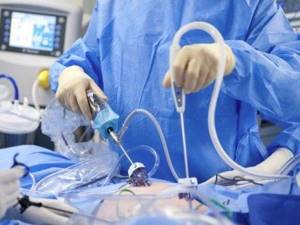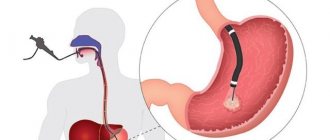Home » Laparoscopy » Laparoscopy during menstruation: is it possible to perform the procedure during menstruation
April 14, 2021 Laparoscopy
Laparoscopy is a minimally invasive method of surgical intervention, through which it is possible not only to diagnose diseases of the pelvic and abdominal organs, but also to perform various therapeutic procedures. Laparoscopy is an improved technology of traditional surgery. Through laparoscopy, it is possible to remove the affected organ or part of it, stop bleeding, and also cure infertility. During the study, the doctor can take samples of tissue particles from a particular organ, through which a more detailed laboratory examination can be carried out. Let’s find out in more detail whether laparoscopy can be performed during menstruation, since this issue is very interesting to the female public.
Features of the intervention
Initially, you should understand what laparoscopic surgery is. During laparoscopic surgery, the doctor makes 3-4 punctures in the abdominal area, which are necessary in order to be able to insert the laparoscope, as well as instruments for performing medical manipulations. A laparoscope is nothing more than a thin steel tube, which is equipped with a video camera and a light source. The diameter of such a tube does not exceed 10 mm. To insert instruments, punctures with a diameter of no more than 5 mm are made.
As soon as the operation is completed, the doctor sews up the puncture sites, after which the patient is transferred to the ward. The main advantage of laparoscopic surgery is the fact that patients can get up and walk around the room already on the second day. The doctor discharges the patient after 3-5 days, if there are no complications. On days 7-10 you need to go to the hospital to have the stitches removed.
After surgery, a woman may feel pain for several days, which is reduced with painkillers. After laparoscopy, the patient should take care of herself, therefore, for a month it is forbidden to eat heavy food, engage in sex and sports, and also drink alcohol.
It is important to know! Equal importance should be given to preparation for surgery, since the success of the surgical intervention depends on the quality of preparation.
Preoperative preparation
| Stages | Name | Process |
| 1st | Premedication | 1 hour before surgery, the anesthesiologist administers medications to speed up the recovery process and improve the state of anesthesia. |
| 2nd | Catheter placement | Occurs in the operating room when prescribed drugs are administered intravenously to a patient. A specialist is monitoring his condition. All data on blood and the working condition of the heart is displayed on the monitor. |
| 3rd | Introduction of anesthesia | The first medications are administered to quickly fall asleep, and subsequent medications simplify the process of inserting the tube into the tracheal tract. As a result, the procedure is painless and effective. |
| 4th | Connection of tube and anesthesia machine | After they are completed, the operation begins. |
The manipulation takes on average 10 minutes.
Is it possible to have surgery during menstruation?
To the question of whether laparoscopy is performed during menstruation, there is a negative answer. In preparation for surgery, special attention is paid to female menstruation. How does menstruation interfere with laparoscopy? There is no consensus among scientists from different countries whether laparoscopy can be performed during menstruation or not. European doctors believe that it is possible, justifying this by the fact that during menstruation, immunity and general activity of the body increase.
Doctors who are against laparoscopy during menstruation justify their point of view by the fact that during this period the level of hemoglobin in the female body decreases and blood clotting decreases. In this case, the postoperative period may last up to 7-10 days. If there is no need to intervene when discharge occurs, then it is better to wait until the end of menstruation.
Risks of having surgery during menstruation
There are a number of certain risks on the basis of which the doctor will refuse to perform laparoscopy during menstruation. The operation is possible in exceptional cases, which are called emergencies. If laparoscopy is performed at a time when discharge occurs, this may contribute to the development of the following complications:
- the possibility of developing varicose veins;
- formation of internal bleeding;
- the occurrence of problems with the cardiovascular system.
Doctors recommend laparoscopy on days 5-7 of the cycle. Carrying out the operation on days 5-7 can significantly reduce the risk of blood loss. Surgery in the first days after menstruation is also not recommended, since the body has not yet had time to recover, despite the fact that there is no vaginal discharge.
If you perform laparoscopy 5-7 days after menstruation, then there is a month of time before the next period, during which the fastest healing of wounds and microtraumas after the intervention will occur. A cycle failure cannot be ruled out when menstruation does not come for several months. This is a normal phenomenon, because the body has suffered stress, due to which hormones have failed.
Menstruation after laparoscopy
How many days will it take to get my period after laparoscopy? It all depends on the purpose of the surgical intervention, as well as the individual characteristics of the female body. As mentioned above, surgery for women is performed mainly on days 5-7 of the cycle. If laparoscopy is strictly performed within the specified period, the menstrual cycle will not be disrupted, and menstruation should come on time. If they did not arrive on time, this does not indicate the presence of violations. You should wait, because often if failures are observed, then with a slight difference of several days.
Do not be upset if the delay after surgery is up to three months. This effect is a normal reaction of the body to surgery, especially if the procedure was performed on the reproductive organs.
It is important to know! If discharge does not appear for more than 3 months in a row after surgery, you should contact a gynecologist.
To restore hormones, the doctor will prescribe special hormonal medications. If your period does not come after a course of drug treatment, then a detailed examination is necessary.
If a woman after surgery discovers that the discharge is more aggressive in nature, then there is no need to worry, as this is also considered normal. In addition, you need to know that the first menstruation can be painful. There is no need to sound the alarm, because this phenomenon is normal.
It is important to know! After surgery, scanty bloody clots may be released from the vagina. Many women confuse this type of discharge with menstruation. Menstruation is different in that during menstruation blood is released in larger quantities.
Let's look at several types of laparoscopic operations and find out how one or another type affects menstruation.
Laparoscopy of ovarian cyst
If the reason for laparoscopy is the discovery of an ovarian cyst, then the operation can be performed as an emergency, regardless of the period of menstruation. During the intervention, the newly formed cyst is removed along with part of the ovary itself.
After ovarian surgery is performed, a decrease in estrogen levels is detected in a woman’s body. When these hormones decrease, women experience bleeding in the form of spotting from the vagina. The duration of such discharge can last from one day to one week.

Laparoscopy for polycystic disease
In polycystic disease, the main goal of surgery is to remove the dense tunica albuginea. This is done so that the follicle has the opportunity to mature along with the egg. During the removal of the membrane, part of the ovary is affected, which contributes to hormonal imbalance.
With such an operation, a cycle disruption is also observed, which is normal. When the intervention is carried out with the aim of further conceiving a child, the use of hormonal drugs is prohibited. Laparoscopy of polycystic disease is performed exclusively on days 7-8 of the cycle. Emergency surgery is not prescribed, which can lead to serious complications.
Laparoscopy for ectopic pregnancy
Atopic or ectopic pregnancy is detected mainly after a delay in menstruation. Laparoscopy for ectopic pregnancy is performed to remove the fertilized egg. After this type of operation, menstruation comes a few days later. Moreover, the discharge is normal in nature without the appearance of severe pain and without heavy bleeding.
To normalize hormonal levels, women are prescribed hormonal medications immediately after surgery. During the day the next day, the woman may experience slight discharge.
What negative consequences can arise?
After surgery, rough scars may remain at the incision sites. The opinion that the seam will be very noticeable only if the operation was performed by an unqualified doctor is incorrect. Scars appear due to the individual characteristics of the body (how collagen metabolic processes occur). During menstruation, such features are usually very pronounced. If scars occur, do not despair. They can be dealt with by grinding them or smoothing them out using injections specially designed for this purpose.
- Various hematomas may appear. This occurs because the blood composition becomes more fluid during menstruation. As a result, bruises appear at the site of tissue dissection. Most often, after a while they go away on their own and no additional procedures are required to remove them. If a woman wants them to go away as quickly as possible, then the doctor can prescribe her special ointments for this and physiotherapeutic procedures.
- Due to hemorrhages that occurred during surgery, age spots may appear. They disappear on their own after a few months.

- Due to excess blood supply to the area where the operation was performed, inflammation or suppuration may occur. According to the observations of doctors, most often they appear in patients whose surgery was performed in the first days of menstruation. Suppuration may be accompanied by symptoms such as high body temperature, redness of the skin, and pain at the operated site. Anti-inflammatory drugs can help cope with such unpleasant consequences.
- Inflammation may occur at the implant site. They arise due to metabolic processes and disruption of the hormonal system in the patient’s body. Inflammatory processes are treated with antibiotics. In some cases, in order to cope with them, it is necessary to remove the implant, which can only be reinstalled after 6 months.
Spotting after laparoscopy
Women often complain that spotting is detected after surgery. After gynecological intervention, spotting is an absolutely normal process. This daub goes away immediately after the first menstruation begins. Spotting can bother women for one to two months until their periods begin. In this case, there is no need to worry, you just need to always wear pads.
Laparoscopy today is the most popular and in demand surgical method, through which not only diagnostics are performed, but also therapeutic manipulations. The procedure has many advantages compared to traditional surgery using an incision. Every day, with the help of laparoscopy, it is possible not only to diagnose serious pathologies, but also to save the lives of women and men.
If, while preparing for laparoscopy, your periods did not come as scheduled, then do not despair. You need to notify the surgeon who will undergo the operation. To avoid unforeseen consequences, you should prepare yourself psychologically. The main incentive for a positive attitude may be that after the operation you will be healthy and get rid of your illness.
Indications for the procedure in gynecology
The most common diseases that can be cured using a laparoscope are:
- endometriosis;
- obstruction of the uterine tubes;
- dysfunction of the reproductive organs;
- uterine fibroids;
- ovarian pathologies;
- inflammatory processes of the appendages;
- infertility;
- tumors, etc.
In addition to the listed diseases, such an operation in gynecology is indicated when identifying persistent pain in the pelvic area, before planning a pregnancy using IVF fertilization, before a biopsy of the uterus and ovaries, as well as to monitor the results of previous treatment.









